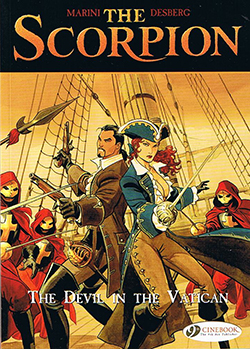 By Marini & Desberg
By Marini & Desberg
Publisher: Cinebook
ISBN: 9781905460908
Well, I really should have been reading this sooner. This is the second book about the sword-weilding 18th Century archaeologist and adventurer, known as the Scorpion because of the strange birthmark upon his shoulder. It is exquisitely illustrated and there’s a nice mix of action, intrigue, desperation and hope, all wrapped up in the rich history of Rome and the power of the Roman Catholic church.
The Pope has been murdered and Cardinal Trebaldi is making his move to make the papacy his own. The Scorpion is determined to expose him, but the Cardinal is surrounded by his warrior monks and any potential allies seem to be dropping like flies, so his actions need to be bold and public. He achieves this, to a degree, but the retaliation strips him of everything, no thanks to the Egyptian Mejai who betrays his whereabouts. Captured, the Scorpion is dragged to the darkest depths of a castle in the countryside and faces a slow and painful death, but Mejai is also there, and a brief altercation leaves the Scorpion in possession of some of her bottled acid and the means to execute an escape. Meanwhile Mejai also learns she is no longer of use and is to be terminated, so the two find themselves in a brief but difficult alliance.
Back in Rome Trebaldi needs to convince enough Cardinals to make him Pope, so when he can’t do this through words (and a bit of light thinning out beforehand) he persuades them to visit his vast home where, in the catacombs beneath it, is a room containing what he claims to be the inverted cross on which St Peter was crucified. It looks like it’s enough to swing the vote but still some cardinals remain convinced of Trebaldi’s darker side and decide to seek out the whereabouts of the true cross – for which they need the talents and skills of the Scorpion. And that means travelling to Istanbul and the introduction of a woman who just may be the Scorpion’s match.
This really is a rip-roarer of a book, and the icing on the cake is Marini’s art. He brings the Rome of the period, existing and expanding within the ruins of its past, to life, and you can’t help but marvel at the care and detail on page after page. The only niggle is that some of the artwork has been altered to cover up some nudity which jars a little, and which seems at odds with the strong language and scenes such as the one where a crossbow bolt is shot into a warrior monk’s eye. But it is a very minor niggle in an otherwise superb book, and is definitely one of the best I’ve read this year.
And if you liked that: Order book three! I’m going to.



No comments yet.